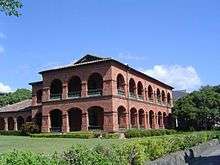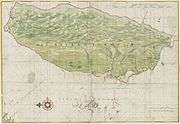Fort San Domingo
| Fort Anthonio | |
|---|---|
| Part of Museum Fort San Domingo | |
| Tamsui District, New Taipei City, Taiwan | |
|
Fort Anthonio. Part of Museum Fort San Domingo | |
| Type | Castle-like fort |
| Site history | |
| Built | 1644 |
| Built by | Spanish conquistadores / Dutch East India Company |
| In use | 1644–1868 |
| Materials | Stone and bricks |
| Fort San Domingo | |||||||||||
| Traditional Chinese | 紅毛城 | ||||||||||
|---|---|---|---|---|---|---|---|---|---|---|---|
| |||||||||||
| Alternative Chinese name | |||||||||||
| Traditional Chinese | 聖多明哥城 | ||||||||||
| |||||||||||
The Fort San Domingo was originally a wooden fort built by the Spanish in 1629 at Tamsui District, New Taipei City, Taiwan. It is located near Hobe Fort, which was built during Qing rule.[1]
History
Spanish Era
After the Spanish established a permanent colony at San Salvador (Palm Island; modern-day Hoping Island), they proceeded in 1629 to occupy Tamsui, "which even at this early period was frequented by many Chinese merchants, who came from Fokien to barter with the Formosa natives."[2] On a night in 1636, a group of local people, angered by the taxes that the Spanish governor had imposed, successfully attacked the fort and demolished it.[3] In 1637, the Spanish rebuilt the fort using stone and raised the walls' height to twenty feet or more. A church was also built on a hill, and the locals helped to make a road to it from the fort. "Peter Nuits the Dutch Governor of Formosa, reported these facts to his home authorities and exposed in an interesting report the injury that the Spaniards were doing to Dutch trade and the necessity of sending an expedition to drive them away."
After a failed first attempt in 1641, the Dutch made a second expedition on the 3rd of August 1642: "the Dutch appeared off Tamsui with a comparatively powerful squadron of four frigates, a large cutter, nine small vessels, besides several transports..."[4] After the Dutch mounted artillery at an elevation commanding the fort, they succeeded in taking the fort on 24 August. The Dutch also expelled the Spaniards from nearby Keelung. The Spanish fort in Tamsui had by then already been razed by the Spanish themselves. It is also claimed that no traces remain of the forts on Palm Island, as they were destroyed by Zheng Jing, son of Koxinga.[2]
Dutch era
The Dutch then became the "undisputed masters of Formosa", and built a new fort on the site, called Fort Antonio. In 1644, they replaced it with the structure still standing today, also called Fort Antonio. The "Old Dutch Fort" made of brick and stone has been described as "impregnable against any engines of war that those early days could produce."[5] The locals called the Dutch "the red-haired people", which led to the compound's Hokkien name (Chinese: 紅毛城; Pe̍h-ōe-jī: Âng-mn̂g-siâⁿ; literally: "ang mo fort").[6]
Chinese era
From 1683 to 1867 the Qing Dynasty Chinese government controlled the fort and during this time (1724) built a stone wall with four gates around it, of which only one, the main gate, survives. Many countries had ruled the fort, near World War II.

Following the Second Opium War, in 1868 the British took over the fort, made it their trade consulate, and painted it red (it was previously white). The fort was struck during the 1884 French bombardment of the Battle of Tamsui but suffered no damage.[5] The linguist Herbert Allen Giles resided in the fort from 1885 to 1888 and completed some of his work on the Wade-Giles system of romanization of Standard Chinese there. Next to the fort the British built their consular residence in 1891.
The Fort is adjacent to Aletheia University, which traces its origins back to 1872 when the Reverend Dr. George Leslie Mackay, a Canadian Presbyterian, established a mission and then a medical service and a school.
Modern era
The consulate closed during World War II and reopened after the end of the war. The Republic of China (ROC) government retrieved the land from the British in 1980,[7] several years after the United Kingdom broke off diplomatic relations with the ROC in 1972. The ROC government has classified the Fort a grade one listed historical site and it is now a museum with the interior recreated from photographs. It was reopened after refurbishment in 2005. Now referred to as the Former British Consular Residence, it is a popular tourist attraction.
Tourist information
The Former British Consular Residence is an elegant Victorian house fused with some Chinese elements. Also, this location provides a beautiful outlook on Guanyin Mountain and the Tamsui River.
The fort is open to the public Tuesday – Sunday, 9am – 5pm. There is no charge for admission.
Transport
The fort is accessible within walking distance North West from Tamsui Station of the Taipei Metro.
See also
| Wikimedia Commons has media related to Fort Santo Domingo. |
- Fort Provintia
- Fort Zeelandia (Taiwan)
- Cape of San Diego
- Eternal Golden Castle
- Taiwan under Dutch rule
- History of Taiwan
References
- ↑ Shan, Shelley (19 Sep 2016). "'Old Dutch Fort' in Tamsui reopens after repairs". Taipei Times. p. 3.
- 1 2 Davidson (1903), p. 20.
- ↑ Tamsui Map+Guide 2011. Tamsui Historical Museum.
- ↑ Davidson (1903), p. 22.
- 1 2 Davidson (1903), p. 23.
- ↑ Governor-General of Taiwan (1931–1932). "âng-mn̂g-siâⁿ (紅毛城)". In Ogawa Naoyoshi. 臺日大辭典 [Taiwanese-Japanese Dictionary] (in Japanese and Hokkien). 1. Taihoku: 同府 [Dōfu]. p. 94. OCLC 25747241..
- ↑ "Fort Santo Domingo, Tamsui, Formosa (Taiwan): decommissioning as British consulate - a Freedom of Information request to Foreign and Commonwealth Office". 22 July 2008.
Bibliography
External links
Coordinates: 25°10′30″N 121°25′59″E / 25.175°N 121.433°E

